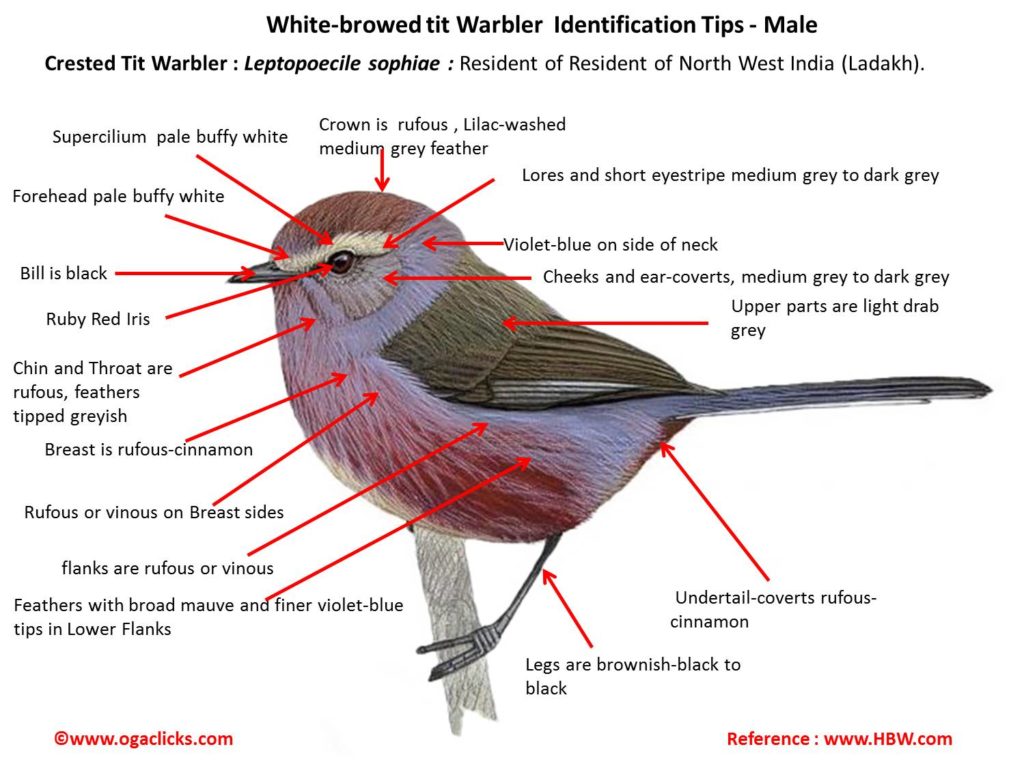
White-browed Tit-warbler Leptopoecile sophiae
Etymology:
- Leptopoecile : Leptopoecile : Greek word leptos –delicate, slender ; genus Poecile – Tit
- Sophiae : Named after Tzarina Sophia Maria Alexandrovna (1824–1880), formerly Princess Maximiliane Wilhelmine Auguste Sophie Marie daughter of Ludwig II Grand Duke of Hesse-Darmstadt, and wife of Alexander II Tzar of Russia
Distribution in India: Resident of North Himalayas from Ladhak to Arunachal Pradesh
Description: Size of 8·5–10 cm; wt.of 6–8 g. It is a tiny passerine with relatively long, graduated tail, males are startlingly coloured, with patches of violet-blue and mauve. The male of nominate race has lower forehead and broad supercilium as pale buffy white (whitest immediately above eye), well defined on lower border but slightly ragged on side of crown. The crown is rufous with lilac-washed medium grey feather tips. The nape, side of neck, mantle, upper back and scapulars are light drab grey, washed violet-blue on side of neck. The rump and uppertail-coverts are violet-blue. The tail is blackish, outer webs of outermost feather is off-white, outer webs of remaining rectrices are diffusely fringed slate-blue at base. The upperwing-coverts and flight-feathers are dark brownish-grey, narrowly fringed slightly paler, fringes more cinnamon-buff on tertials, and a little paler and better defined with slight blue cast on basal half of primaries. The lores and short eyestripe are medium grey to dark grey, cheek and ear-coverts are tinged medium grey .The chin and throat are rufous, feathers tipped as greyish, feathers of lateral and lower parts of throat are broadly tipped violet. The side of breast and flanks are rufous or vinous, feathers with broad mauve subterminal area and finer violet-blue tips , centre of lower breast and belly are dull white, washed buff, undertail-coverts are rufous, thighs are dull cinnamon-buff. The iris is reddish; bill is black; legs are brownish-black to black. The female is much duller than male, broad light brownish-grey supercilia meeting on forehead. The crown is dull cinnamon-brown, upperparts and wing as male, rump and uppertail-coverts with narrower and less richly coloured mauve tips; lores and short eyestripe are medium grey, cheek and ear-coverts are mottled light greyish-brown, underparts are pale brownish-grey with rufous area restricted to lower flanks, where feathers tipped mauve. The thighs and undertail-coverts are greyish-buff; iris is reddish-brown. The Juvenile is very like adult but plumage slightly softer and duller, male is as adult female but crown is brighter and more rufous. The rump and uppertail-coverts are cinnamon with more restricted and less conspicuous mauve tips, pale fringes on outer rectrices are duller and more restricted, underparts are duller and greyer, washed mauve on throat and with more extensive cinnamon on side of breast and flanks, where feathers are tipped mauve, bill is paler. The juvenile female is similar, but rump is cinnamon-brownish without mauve or lilac, underparts are dull buff-washed white, with very restricted cinnamon-brown on flanks and no lilac or mauve tones, iris is dull olive-brown.
Habitat: It is found in Montane forest, scrub and thickets. It is found from 2000m up to 5000m from sea level.
Food Habits: It eats small insects and spiders; also, mainly in autumn and winter, small quantities of seeds and berries. The nestlings are fed insects and spiders. It forages among herbs and shrubs, where very active and agile; it forages on ground, investigating root tangles and lichen-covered rocks. It catches insects by aerial flycatching. In winter months may join mixed-species foraging flocks
Breeding habits: They breed in May to Jun. They are single-brooded. The nest is built by both sexes, work divided equally, taking 6–8 days for framework and almost as long for lining. The nest is an oval ball with circular entrance on one side towards top, outer layer of coarse material such as large pieces of moss, thin stalks, spider cocoons, and lichen. The inner layer is of same material as well as plant hair, wool, dead leaves, feathers and the like, and lining mainly of feathers. They use downy feathers from Himalayan Snowcock and Chukar partridge to stick up in nest and form “elastic funnel” at entrance. When adult enters, the entrance closes behind it. The nest are very well concealed in scrub ,usually in upper part of bush, supported by small branches at sides and base, with walls woven around larger branches. They lay a clutch of 4–8 eggs .The incubation is done by both sexes. The incubation period is14–17 .Both the sexes brood chicks for first c. 7–8 days, and roost in nest with them. The young leave nest at 18–20 days but remain close to nest and roost there for 7–12 days after fledging.